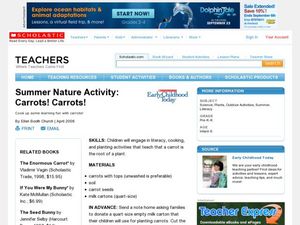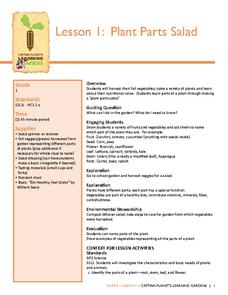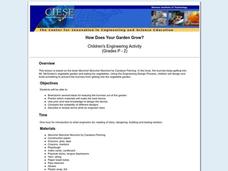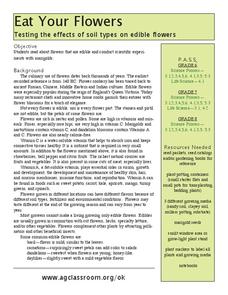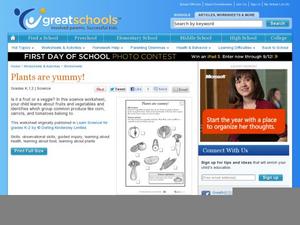Curated OER
Summer Nature Activity: Carrots! Carrots!
Young scholars investigate reading, cooking, and planting activities that teach that a carrot is the root of a plant. In this early childhood science lesson, students explore the world around them as they read The Carrot Seed and...
Captain Planet Foundation
Plant Parts Salad
How are vegetables beneficial to a healthy diet? Have kids examine different types of vegetables, such as zucchini, broccoli, and carrots, and determine which parts of the plant they represent. Then, they taste the vegetables as a...
Captain Planet Foundation
Fall into Healthy Shapes
Kindergartners identify geometric shapes by planting a fall garden. They start their seeds in containers that have different shapes, and keep track of their plants based on those shapes. This brilliantly designed and incredibly thorough...
Curated OER
Flower Pot Salad Bar
Students discuss the connection between a flower pot and wholesome food by creating a salad. In this healthy eating activity, students utilize numerous fresh vegetables to create a classic salad in a flower pot. Students...
Curated OER
Plant Parts We Eat
I bet the kids in your class will love to eat their vegetables after an engaging lesson about edible plants. They read information about vegetables and edible plants, sort vocabulary words, identify plant parts, measure and graph the...
Curated OER
Carrot Sticks or French Fries?
Students investigate the influence of fast food brand names on food choices and analyze the factors that contribute to branding preferences. They write an opinion essay on the corporate responsibility to influence food choices.
Curated OER
Vegetable Flowers with Homemade Ranch Dip
Vegetables aren't just things we can grow to eat; now they are things we can grow to create art! Use this cute and kid-friendly recipe during your next Earth Day celebration. It includes step-by-step instructions on how to turn...
Curated OER
PLANT PARTS WE EAT
Students identify an assortment of vegetables and learn how to locate the parts humans use for food. Students identify the plant parts we eat. Students color the pictures on their worksheets as provided. Students match the plants to the...
Curated OER
Tops and Bottoms
First graders classify vegetables by which parts are edible. In this plant biology lesson, 1st graders are read Tops and Bottoms by Janet Stevens, participate in a discussion of which plant parts are edible in the story, then sort...
Curated OER
Parts of the Plants that we Eat
First graders study plants and their parts to see what parts are edible. In this plant instructional activity students are assigned plant parts and they are to put them in the right category.
Curated OER
Plant Parts and their Function
Discover why plants are important to our world. View plant parts and categorize them as stems or buds. Students do a cut and paste of pictures of plants into correct categories. Students also plant a carrot top,and record...
Steven's Institute of Technology
How Does Your Garden Grow?
What to do, bunnies are getting into the garden and eating all the carrots! After reading the story Muncha! Muncha! Muncha! the class works together to design a device that will keep those bunnies out of the garden. They get together in...
Curated OER
Eating Plants
Students identify parts of a plant. In this life science instructional activity, student groups locate the leaves and fruits on vegetables, then find the roots. Lesson includes extension activities and background teacher information.
Curated OER
Healthy Snacks Project Lesson
After learning why it is important to limit salt, fat, and sugar in their diets, divide your class into pairs or groups to complete this project. Each group will create two charts: unhealthy and healthy foods. They will cut out food...
Curated OER
Chew on This: Worksheets 1 - 5
In this fast food worksheet, students answer 21 questions pertaining to the fast food industry. It appears as though they should read the Chew on This article, but it is not included in this packet. This packet contains worksheets 1...
Curated OER
Race to the Eating Line
Seventh graders investigate the steps in writing a newspaper sports article and utilizd the information to report their class car race results. The racing cars are built out of vegetables and fruit and entered into the class competition,...
Curated OER
Eat Your Flowers
Middle schoolers grow flowers in different soil mediums to determine the effect on flavor. In this investigative lesson students study flowers, plant them and taste them to see how they differ in different potting soils.
Curated OER
Summer Activities: The Wonders of Nature!
Students examine the world of nature. In this early childhood lesson plan, students develop observation skills as they bird-watch and make rainbows, experimentation skills as they explore seeds and carrots, prediction skills as they...
Curated OER
Those Amazing Earthworms- A Worm's World
Students investigate earthworms. In this organisms lesson, students observe earthworms in their environment and record their behavior towards light and how they eat. Students continue on a month long observation.
Curated OER
Plants are yummy!
Is it a fruit or a vegetable? Youngsters place an F next to each fruit they see and a V next to the vegetables. Corn is tricky. It is a grass, so it's actually not a fruit or a vegetable, but a grain!
Curated OER
Edible Plants
Students determine what part of a plant they are eating when they eat different fruits and vegetables, and make collages of fruit and vegetable pictures that are flowers, fruits, leaves, roots, seeds, seed pods, stems and tubers.
Curated OER
Fatty Food
Learners explore nutrition by participating in a balanced diet activity. In this eating habits lesson, students analyze their own diets and discuss the foods they have eaten that day. Learners utilize grocery bags, scissors, Ziploc bags...
Curated OER
Snowman
Students read books, learn about the letter s, and eat snow all to learn about snowmen. In this snowman lesson plan, students also view ice melting and sing songs.
Curated OER
Oklahoma's Roots and Leafy Greens
Students explore valuable food sources. They examine vegetable that have roots and leafy greens that we eat. They also discuss the various used for the leafy greens of vegetable plants. Students create a carrot necklace using carrot slices.
